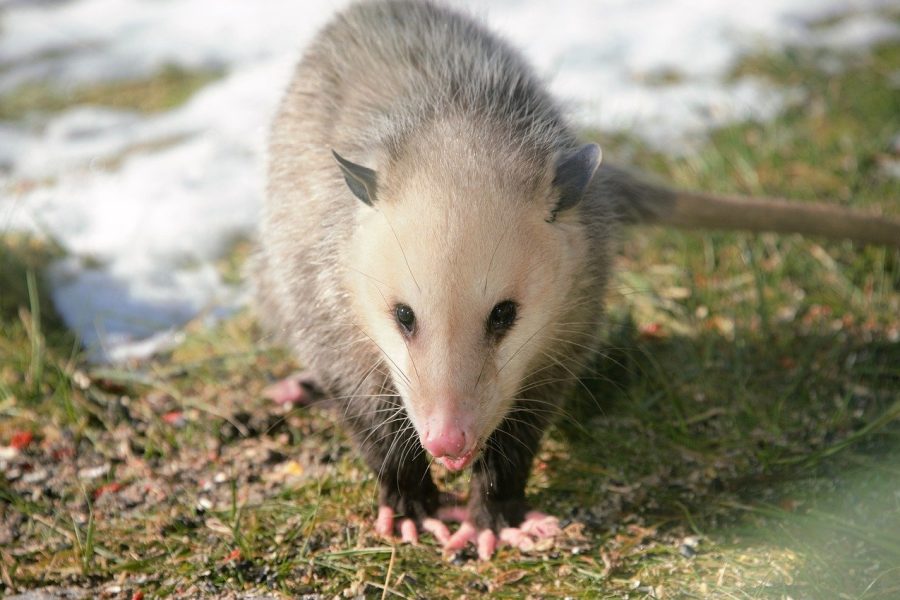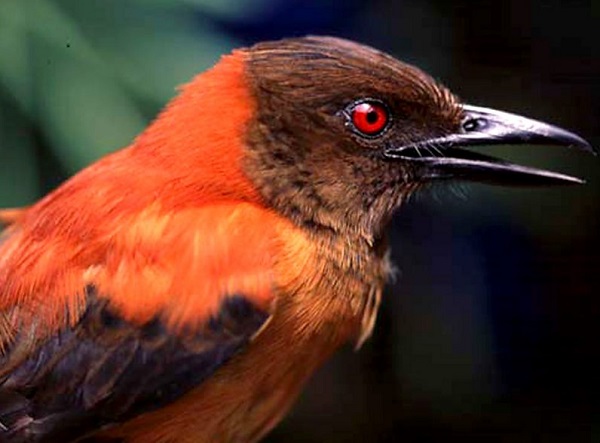While most animals in the world rely on things like teeth and claws, camouflage, speed, or tricks to protect themselves, some take things to the next level. Some have even come up with biological methods of modern warfare using projectile and explosive weapons.
10. Bombardier beetles fire boiling chemical bombs
You can't talk about creatures that use artillery as a defense mechanism without mentioning the bombardier beetle. These tiny bugs unleash a full-blown chemical attack on anything stupid enough to eat them, which is reminiscent of the explosives used in Die Hard with a Vengeance, giving the beetle a ton of extra street cred.
Inside the beetle's abdomen are two sacs. One contains hydrogen peroxide. The other contains hydroquinone. You're probably familiar with hydrogen peroxide, as most of us have it in our medicine cabinet or first aid kit. Hydroquinone is also used cosmetically as a skin-lightening agent that reduces melanin levels. They're also generally pretty safe.
When the beetle is threatened, it shoots these chemicals out of its rear end, mixed with a third compound that acts as a catalyst and causes an instant chemical reaction. The two normally harmless chemicals mix to form boiling water and benzoquinone. The spray and gas mixture hits the beetle's target at 212 degrees Fahrenheit or 100 degrees Celsius (the temperature of boiling water).
Small creatures such as other insects will be killed immediately. Larger creatures may be blinded, and even humans will suffer burns and scars. This is not only due to the temperature, but also the caustic nature of the chemicals, which can also affect the respiratory system.
The beetles have enough juice to fire about 20 bursts before they run out, and they are also known to have impeccable aim. The hole through which they fire the mixture can rotate 270 degrees, which also helps them target predators, meaning there aren't many safe ways to get to a bombardier beetle.
9. Velvet worms shoot slime from the turrets of a biological cannon.
In the animal kingdom, being blind doesn’t mean you can’t take a shot when you need to. Velvet worms live in forests and jungles around the world and there are over 200 species. They’ve developed a unique defense mechanism that’s been described as a “stupid chain of death,” so you know it’s got to be good.
The worms sense changes in air currents to know when prey is nearby, and then when they get close enough, two nozzles emerge from their heads, releasing foot-long ropes of mucus. The substance coats the target and dries quickly, pinning the victim in place. It can also be used defensively to escape a predator, either holding the small predator in place or at least slowing it down when it's dealing with a face full of quick-drying ooze.
Once trapped, the worm can approach the prey and use a knife-like protrusion in its mouth to cut a hole in it. They then fill the trapped snack with digestive saliva, which liquefies it and allows the worm to swallow it instead of doing something messy like chewing.
8. Hagfish secrete mucus that expands 10,000 times.
The velvet worm may think it's a tough guy with its little slimy ropes, but the hagfish is the ultimate slimy goat in the animal kingdom. These repulsive creatures have no jaws or spines, live on the ocean floor, and have changed little in 500 million years. But that's not why they're famous.
When threatened, hagfish secrete mucus. This is a defense mechanism designed to ward off predators and prevent fish from eating them. Everything is going well. But hagfish mucus is unlike anything you can imagine. Their bodies are covered in glands that secrete mucus and miles of thread-like compounds to deter predators. Once this material hits seawater, it expands at a staggering rate. The mucus will grow 10,000 times its size in an instant, turning the water into jelly in the blink of an eye.
If a predator tries to eat a hagfish, it will have to retreat immediately or face suffocation, as its mouth and gills are filled with mud that it cannot breathe and cannot escape. Not only is the substance incredibly soft, but it is also elastic and surprisingly strong, so you can simply break through it to escape.
7. Sea cucumbers shoot internal organs from their anus
Sea cucumbers won't be winning any beauty contests anytime soon, but they are getting a lot of attention for their unusual self-defense strategy. They use their butts as cannons and shoot out their insides.
There are different variations on how this works, depending on the species of sea cucumber. Some shoot out internal organs, like a fighter jet firing flares to attract enemy missiles, which then grow back. Others shoot out strings of sticky material that can trap potential predators while the cucumber escapes.
In the latter case, the threads released are called Cuvier's organs. These tubes are attached to the organs that cucumbers use to breathe, and they do so through their butts. If a predator approaches and tries to eat the cucumber, the organs are ejected and expand, filling with seawater.
Because they are sticky like spider webs, they can trap their attacker and sometimes even kill them if they cannot break free.
6. Texas horned lizards shoot blood from their eyes.
Sometimes, a tough and dangerous appearance isn’t enough to convince a predator to leave you alone. For example, the Texas horned lizard looks like a dangerous little foe to any predator. Its back is covered in the aforementioned horns, making it look like a modern dragon. It also camouflages itself very well, hiding in sandy and rocky areas in and around its habitat. But it still has a hidden defense in case the horns and hiding don’t work.
Because horned lizards are small, about the size of a bullfrog, they are vulnerable to larger predators even with their spines. To ward off these creatures, the lizard shoots a stream of blood from its eyes, like a horror movie come to life.
When threatened, the blood flow to the lizard's head is restricted. This causes the eye socket to fill as the pressure builds. The lizard can then contract the muscles around the eyes and force the socket to burst out, shooting a stream of blood up to five feet away. They can also do this multiple times.
Few animals enjoy being splashed, just try spraying your cat with a bottle of water occasionally, so this tactic can be quite effective. Also, blood apparently tastes bad, so it helps to dissuade predators from moving on.
5. Northern gulls use vomiting as a defense mechanism.
When it comes to violently shooting a predator or prey, biology gives us a lot of options. Whatever is being shot has to come out of an orifice somewhere, and most life forms have a lot of options. For fulmar gulls, that’s the mouth. And the ammunition they fire comes from the most obvious place you can think of: their stomach. These gulls use vomit as a weapon.
The stomachs of fulmar gulls contain oil that is described as unpleasant and sticky, so we suppose that's a good start. If a bird of prey comes to their nests, the birds may vomit on them to make them go away. But their use of this weapon is more insidious than just disgusting.
When seagulls tear at other birds, they strip away the coating that seabirds need to stay afloat. It can also tangle feathers so that the bird can no longer fly, which is essentially a death sentence for any bird.
4. Archerfish shoot jets of water at their prey
We've already covered a couple of underwater creatures that have created effective defenses while underwater, but the archerfish is a little different. Although it lives in the water like any other fish, its weapons are designed for prey on land and in the air.
Described as an "anti-aircraft gun," the archerfish can shoot a jet of water into the air to knock prey out of the sky or off plants hanging over the water. Once the prey hits the water, the fish can pounce and swallow it whole.
At just a few inches long, the fish's prey isn't particularly large - usually just tasty-looking flies or crickets. But the archerfish can spot them from the depths, rise to the surface, and fire a jet of them several feet away with astonishing accuracy, so accurate that it can tag the insects in mid-flight.
Even if the aim is a little off, the archerfish is an automatic weapon. In one gulp of water, it can fire up to seven shots in a row to hit a target. Research has shown that the fish probably won't need to do this, as they rarely miss.
3. Spitting spiders spit silk onto their prey.
Arachnophobia is a common fear among humans, and it is reasonable to assume that smaller insects are afraid of spiders too. Their webbing and venom make them formidable predators. The only good thing is that many of them are passive, and even the aggressive ones have to chase their prey. Except for spitting spiders.
As the name suggests, spitting spiders can attack prey with their spit. The spit attacks are carried out at speeds of 30 meters per second, which is more than 67 miles per hour. It traps the prey in silk, holding it in place so that the spider can quickly inject venom into it.
2. There is an explosive type of termite
In the jungles of French Guiana, there is a species of termite that spends its entire life waiting to die. Philosophically, you could make that argument about any living thing. But these guys take it to an explosive new level.
As these termites age, their bodies secrete a blue fluid, produced by a pair of specialized glands. The fluid crystallizes in an abdominal sac and just sits there. As the termites age, more and more of it accumulates, so that the oldest termites get an unhealthy dose of the stuff that they can never use. But then again, they could.
If the colony is attacked, the oldest termites become the line of defense. As these termites get older, they are less useful to the colony as foragers and workers. Their jaws become duller over time, making them slower and less useful. But their blue crystals still make them valuable.
When threatened, a termite can cause its sac full of crystals to explode. This mixes with its saliva to form a toxic solution that can paralyze and kill attacking termites. The older the termite, the more severe the reaction, and although the termite also dies, it does so to protect younger members of the colony.
1. Pygmy sperm whales shoot clouds of feces
Whales rarely have to worry about predators, with the exception of humans. In the wild, few animals will challenge a whale simply because of its size. But that only applies to large whales, and not all of them reach monumental proportions. Take pygmy sperm whales, for example. At eight to 14 feet, they are within striking distance of sharks or killer whales.
To escape predators, pygmy sperm whales have developed a unique form of smoke bomb defense. Except instead of smoke, it's poop. Inside their intestines is a sac filled with a dark, reddish-brown liquid. In extreme cases, they can eject three gallons of sludge, creating a squid-like inky cloud that gives the whale time to escape.














Оставить Комментарий